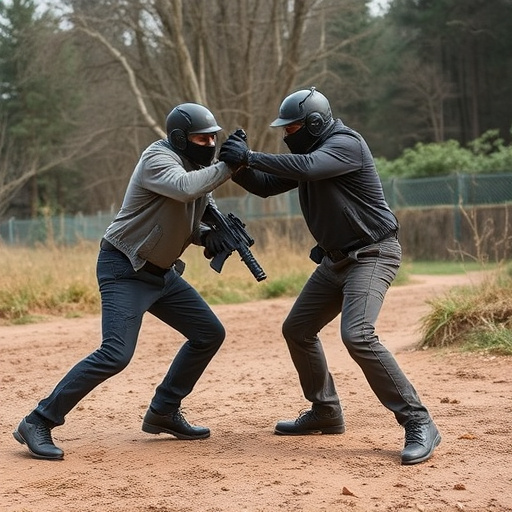The strongest legal pepper spray concentration, typically 2% capsaicin units (CU), balances effectiveness in crowd control and de-escalation with safety protocols. Regulated by regulatory bodies to ensure public safety without exceeding force boundaries, it aids law enforcement in high-risk scenarios like riots, providing precise control without lethal effects.
“Uncovering the power behind police-grade inflammatory pepper spray compounds, this article delves into the intricate chemistry, legal framework, and safety protocols surrounding high-strength formulations. From understanding the unique properties of capsaicin to navigating stringent regulations, we explore what makes these sprays effective tools in law enforcement and security sectors. Discover the science and considerations behind the strongest legal pepper spray concentration, vital for professionals demanding superior protection.”
- Understanding Pepper Spray Chemistry
- Legal Considerations for High-Strength Formulations
- Effective Dosing and Safety Protocols
- Applications in Law Enforcement & Security
Understanding Pepper Spray Chemistry
Pepper spray, a powerful law enforcement tool, operates on a complex chemical principle. At its core, it’s a capsaicin-based compound that targets the human body’s sensory system. Capsaicin is the same chemical that gives chili peppers their heat. The strongest legal pepper spray concentration typically contains a high percentage of this active ingredient, often measured in parts per million (ppm).
Understanding the chemistry behind pepper spray helps explain its effectiveness. When sprayed onto the eyes and skin, capsaicin binds to pain receptors, causing intense irritation and temporary numbness. This disruption leads to the characteristic stinging sensation and tears, enabling law enforcement to subdue and control individuals. The specific chemical composition and concentration determine the spray’s potency, ensuring it remains a powerful yet legal tool for maintaining public safety.
Legal Considerations for High-Strength Formulations
When it comes to high-strength inflammatory pepper spray compounds, legal considerations play a pivotal role in their development and deployment. The strongest legal pepper spray concentration is often a subject of debate, with regulatory bodies striking a delicate balance between public safety and individual rights. In many jurisdictions, the use of such potent sprays is restricted to law enforcement agencies due to their intense effects, which can cause significant discomfort and even temporary blindness.
Regulatory frameworks typically dictate the maximum capsaicin concentration allowed in commercial pepper spray products, with variations based on intended use and legal classification. Manufacturers must adhere to strict guidelines to ensure their products remain within legal boundaries, offering effective deterrence without crossing into excessive force territory. This careful regulation is essential to maintain a harmonious relationship between public safety measures and civil liberties.
Effective Dosing and Safety Protocols
Effective dosing is a critical aspect of using pepper spray as a self-defense mechanism. The strongest legal pepper spray concentration, typically measured in capsaicin units (CU), should be balanced with safety protocols to ensure its optimal use while mitigating risks. A concentration of 2% capsaicin is generally recognized as the most effective and legally acceptable level for personal protection.
Safety measures include proper training, understanding the spray’s range and duration, and ensuring adequate ventilation in enclosed spaces. Users should also be aware of potential side effects such as respiratory irritation, eye damage, and allergic reactions. Regular practice and adherence to manufacturer guidelines are essential to deploying pepper spray effectively and safely.
Applications in Law Enforcement & Security
Pepper spray, with its powerful compound capable of neutralizing an individual’s ability to fight or flee, serves as a crucial tool in law enforcement and security operations. Its primary application lies in crowd control and de-escalation scenarios, allowing officers to temporarily incapacitate agitators and maintain order. The strength of pepper spray is typically measured by the concentration of capsaicin, the active ingredient responsible for the burning sensation it induces. Among the various formulations, the strongest legal pepper spray concentration offers exceptional effectiveness, ensuring swift and safe disruption during high-risk situations such as riots or violent protests.
This specialized equipment plays a vital role in securing public spaces, critical infrastructure, and protecting vulnerable individuals. Its non-lethal nature makes it a preferred choice for law enforcement agencies worldwide, who rely on its precision to control disturbances without resorting to lethal force. The strategic deployment of pepper spray can significantly enhance the safety of officers and civilians alike, making it an indispensable asset in modern security protocols.
Pepper spray, a powerful tool in law enforcement and security, has evolved significantly due to advancements in chemistry and a need for effective crowd control. The development of high-strength formulations, while legally navigated, requires precise dosing and safety protocols to ensure responsible use. Understanding the chemistry behind pepper spray allows for the creation of potent yet safe compounds, making it an indispensable tool for maintaining public safety without causing lasting harm. In terms of strongest legal pepper spray concentration, ongoing research balances efficacy with regulation, ensuring its strategic deployment in various security applications.
